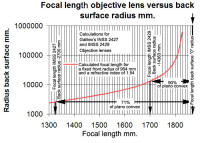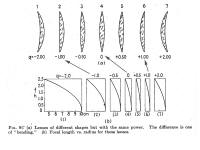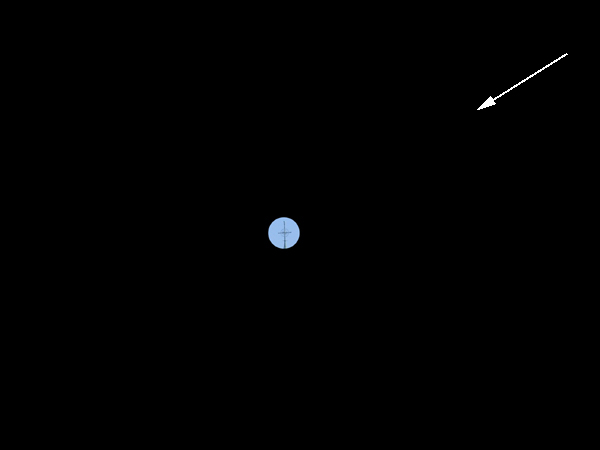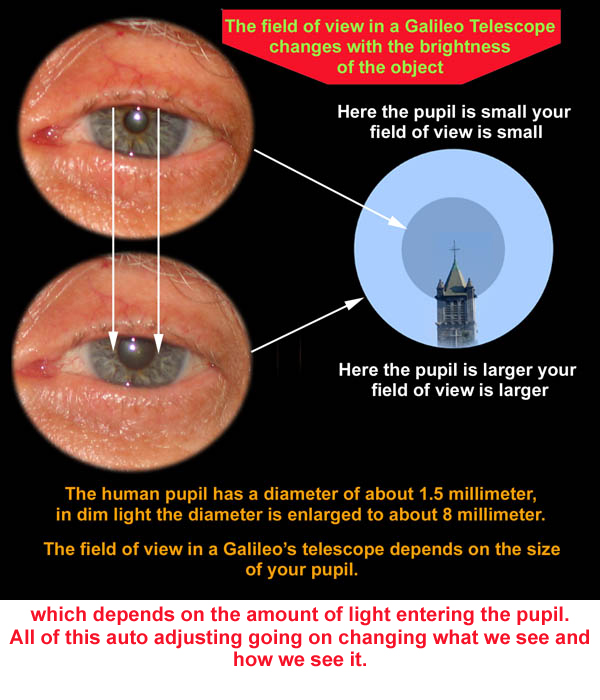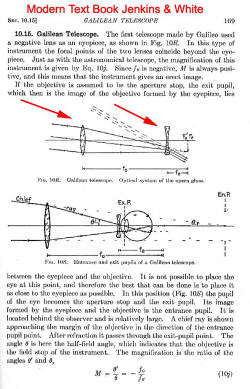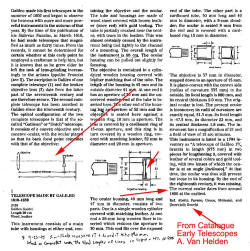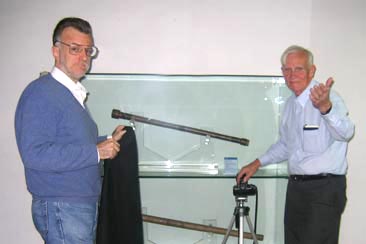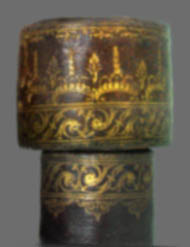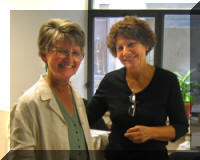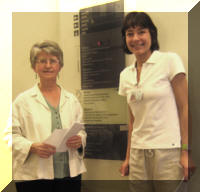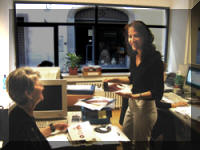1.
Lens shapes and inconsistencies
in the literature of Galileo' existing telescopes, in the drawings and
actual data for the optical
systems.
With great respect for the very valuable
and beautiful
resource "Catalogue of Early Telescopes" for the famous
collection at IMSS, we find an interesting mixture of
drawings on the optics. On page 30 the author, describing
Galileo's leather telescope in some detail, shows a
symmetric biconvex /
biconcave diagram for both lenses although the
objective lens is described as plano convex in the text. Also the diagram of the
objective lens in its lens housing is portrayed as biconvex. In the
appendix of the catalogue, pages 99 through 111 "The Optical Principals of Telescopes"
written by another author are
a mix. Fig 9 uses biconvex and biconcave for the
"Optical layout of the Galilean telescope". By remarkable contrast many of the more
sophisticated optical designs further on in the catalog use
a more accurate mixture of bi-lenses and plano-lenses in the
figures. See our figure 1
above for the corrected drawing based on the following data
from the IMSS Catalogue descriptions of the Galileo telescopes in
their possession:
Galileo's telescope, IMSS 2428, consists of a "plano-convex"
objective and a symmetric biconcave eyepiece for the current lens
with a suspicion
on our part that the original was a plano-concave eyepiece.
(Please see the earlier discussion on this subject which is linked from the
home page.)
Galileo's IMSS 2427 has a non symmetric double convex objective and a
plano concave eyepiece. Galileo's broken objective lens, IMSS
2429, is a non symmetric , nearly a plano - convex
lens. See the figure 1 above for the drawing that, given our current knowledge,
more correctly shows the actual lens shapes for all of the
known Galileo lenses. So!
It makes many of us wonder - can't we get the drawings of the two
little pieces of glass, the heart of the instruments, closer to the
actual lens shapes for three of the worlds most famous
telescopes? It certainly made a difference for us in
precisely replicating
Galileo's telescopes and making choices for the lenses. Using data from Refs 1 & 2 we can take the ratio of the back to front surfaces and see how symmetrical the lenses are.
So our conclusion about drawings: It is unreliable to assume that
drawings of the lens shapes appearing in text books and published papers are
correct and / or consistent with the actual shapes of
the lenses used in the system. It appears that generally for
simple optical systems such as a telescope it is traditional for the
artist to show all the lenses as either double concave or
double convex. This is certainly true for most
illustrations of the earlier telescopes. The actual lenses more than likely have one
side of the lens flatter than the other. So again the
reader should be on the alert that the diagrams outlining the optical
layouts are neither to scale
nor are the lenses shaped as they are measured for the actual telescope.
6. Differences in and problems related to the measurements of the overall lengths of Galileo's existing telescopes. Click here to see us measuring the lengths of the original Galileo's Telescopes at IMSS in Florence Italy. Both IMSS 2427 and 2428 are reported to have the same length as the focal lengths of their objectives. This is an optical impossibility if the telescopes are to focus at infinity. The Galilean design, with the negative eye piece lens, requires the overall length of the telescope to be shorter than the focal length of the objective minus the focal of the eyepiece. i.e. If the lengths of the telescopes are correct as reported then the objectives would have to have been of longer focal lengths, suggesting that the present lenses are not the originals!
Optical telescope length = focal length objective
minus the focal length of the (negative) eyepiece. Click
on the picture below to make it larger The same issues hold for telescope number 2427. We will leave it to the readers to explain why
scientific data
should be described so unscientifically. |
|
Can one use Galileo's two telescopes in doors? Important topics
surrounding what one sees looking through Galileo's telescopes |
|
Yes depending on the size of the room. Even though most everyone knows that telescopes are generally used to bring thing that are far away closer, that the closer the object is the further one has to pull out the eyepiece to focus on that object. Of course the distance one can pull out the eyepiece before it falls out of the telescope is limited to how long it is. The graph below gives us the information for the shortest distance the object can be from the front of the telescope. We have designed and additional eyepiece for use with the IMSS#2427 telescope
|
|
7. The bottom line: Looking through the telescope. The real field of view and how and why it changes. The field of view is not always 15' as
advertised but it's a dynamic field of view depending on the individual
observer (see the explanation below). |
|
Other web sites show you just the magnified view of the object which can be very misleading. Some would say they are in error because they are not what really see's. The first image Galileo saw was also a tiny mottled spot of light surrounded by darkness way at the end of his telescope tube and the little detail that he could see, was dancing wildly around with each slight movement of his telescope. But he had great observational skills and quickly discovered the growth of the image and its detail as we explain below. So don't be disappointed when you look through one of Galileo's telescopes but marvel at Galileo's skill, his extraordinary brilliances as an observer and as an interpreter of what he saw and what it meant to all of us. |
Below is what one first sees looking through Galileo's telescope
This is quite different from what most pictures
show you in the literature, but it clearly demonstrates how
good Galileo's observational skills had to be to make his discoveries.
|
|
Below is a wide angle view from the same location and the same scene
taken
while we were collecting shots for the History
Channels program on Galileo. The arrow points at the church carrying the
steeple we were photographing through the replica of Galileo's
telescope.
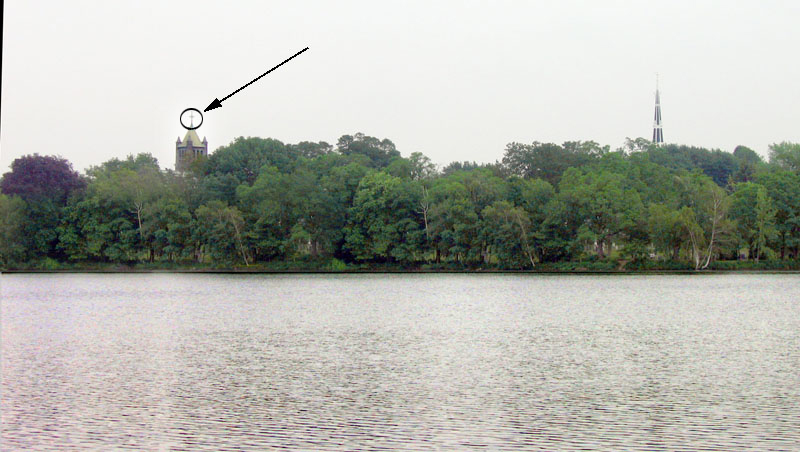
Return
to Antiques of Science & technology
|
8. Why does the image grow and improve as the observer concentrates on it? Much of the literature reports that the optics of a Galilean telescope has a calculated angular field of view of 15 minutes of arc. That is, if the object is a 1000 feet away from the telescope one would only see what is included in a 4 foot diameter circle of the object. However few authors have noted that the Galilean telescope's field of view is largely determined by the pupil of the observer's eye instead of baffles in the optics and that the size of the pupil changes with the amount of light entering the eye. For example, normally the pupil of the eye has adjusted to the ambient light of the surroundings before looking into the telescope. Thus if the sun is out, the pupil of the viewers eye is quite small. Thus what one first sees looking into the telescope is a field of view that is just a small point of light surrounded by a sea of darkness. The darkness is a combination of the optics and partly because the rods and cones in the eye have not become dark adapted. The field of view changes with time. As the observer looks into the telescope in this low light level the pupil and the rods and cones adjust themselves to the lower light level and becomes larger increasing the field off view and consequently the observer begins to recognize more details in the object. See the picture below showing the changes of the pupil diameter for two light levels. The upper picture shows a pupil in brighter light conditions than the eye below. Last but not least, although the real field of view is small, by scanning the head back and forth up and down the observer can see much more of the object it's not much different than looking through a pin hole. This effect of seeing more of the object is what we call the virtual field of view. |
|
The figures above show only relative changes to illustrate the phenomena. |
|
The Kepler versus Galileo eyepiece design issues. 9, The field of view issue: Comparing the field of view with a singlet positive lens versus a negative lens for the eyepiece i.e. Galilean versus Kepler eyepiece design. There are important trade offs; while Kepler design gives a larger apparent field of view the eye relief can be upwards 2 inches (That is the distance between the observers eye and the lens) which makes it quite difficult to actually hold a steady view of the object. One has to hold head very steady without a reference point to lean on. The slightest movement of the telescope or the eye causes one to lose the image entirely. ( Using the negative lens however this is not the case). Combine this frustration with the fact that the Kepler's images are upside down and move in the opposite direction than the telescope moves. By comparison neither happens with the negative lens. What one sees is what one gets. In fact one quickly learns to move the eye around to get a wider view of the object, a view which is about the same as the Kepler design. Remember it took nearly several decades for the users to switch to the Kepler design. There were practical reasons in Galileo's choice! There are some who have not had the opportunity to actually look through both systems before weighing these experimental issues, yet critiquing Galileo's lens as a poor choice. |
| Below two picture comparing the images from a
980mm fl objective using a negative versus positive eyepiece Remember that each of these photographs is extracted out of the center of a much larger picture frame with the rest having a black background. In this example the camera iris could be altering the field of view. but it is adequate for the demonstration. |
| 10, Why Galileo most likely chose a negative lens as his eye piece over the positive lens. The so called Kepler eyepiece design. Both would have been available but most would have been positive lenses from the local opticians. |
| The premises Historians tell us that one of Galileo's activities was making engineering instrument for sale so it is reasonable to assume that Galileo designed his telescope for terrestrial use by untrained observers, not astronomical use. At the time there was no reason to design a telescope for looking up at the heavens because people had been looking up for thousand of years and nothing much was new. Which gives those with product development experience a fundamental insight into Galileo's development of his telescope. During Galileo's development period of the telescope his most immediate source for lens was the local optician who made eyeglasses and magnifiers for the visually challenged. The focal length of these lenses would be quite short and most certainly would not have included many if any weak lenses in neighbor of a half of a diopter of 1000mm f.l. or greater because they would have been of little use to the buyer. The other issue that many may not have considered is that eye glass and magnifiers would have been available for hundreds of years before Galileo and it would be inconceivable that at least one optician would not have tested from his box of lenses various combinations of them stumbling over the telescope and microscope time and time again.
The product trade off's 1, The magnification is the same for both eye pieces. The field of view is larger for the positive eye piece but the image is upside down and moves in the opposite direction of the movement of the telescope, a decided disadvantage at high power. Galileo as a manufacturer and seller of scientific / engineering instruments recognize that these would be considered to be flaws to his untrained costumers. 2, On the other hand one can see
about the same area of the image with a negative lens by scanning one's
eye over the eyepiece, plus one has an upright image . Combine this with
the fact that the telescope with the negative eye piece is
considerably shorter than the one with the positive eyepiece make
the telescope
easier to carry around. Last but least his goal was to make a
marketable product to make his money in a hurry before the competition
from eye glass producers got there first. He had to be aware
of the possible commercial value of selling and licensing the production
of high power telescopes. The scientific trade off's The bottom line. |
| 11. Additional schematic showing light rays passing through lenses and further examples from well known texts on optics with inconsistent lens shapes for Galileo's lenses. |
 |
 |
References
|
| Below are the Adler Planetarium staff that were so helpful to Jim on the visit to the Cipriani replica of Galileo's # 1 & #2 telescopes in Chicago Ill . Their professional help and patience helped significantly to our making the replication of the orginal Galileo telescopes more precise than has been done before. _Thank you again Jim & Rhoda Morris |
|
Michelle Nichols, Master Educator Adler Planetarium & Astronomy Museum |
 The beautiful Cipriani replica of Galileo's # 1 telescope being treated with the care and attention it deserves. |
Devon L. Pyle-Vowles Collections Manager Adler Planetarium & Astronomy Museum |
The authors extended their deepest thank you to all those that helped the authors in this project. Epecially those at the IMSS without whose help we could never had so much success.
| Ref 1. Vasco Ronchi etal L'Universo 4, 791-804(1923) |
| Ref 2 V. Greco, G. Molesini, and F. Quercioli Nature (London) 358, 101 (1992) |
| Ref 2a. V. Greco, G. Molesini, and F. Quercioli Applied Optics 32, 6219-6226 (1993) |
| Ref 3. Jenkins & White Fundamental of Optics 2nd edition McGraw- Hill 1950 |




